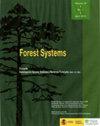Age-age correlations and prediction of early selection age for diameter growth in a 35-years old Pinus brutia Ten. Genetic experiment
IF 0.7
4区 农林科学
Q3 FORESTRY
引用次数: 3
Abstract
Aim of study: Forest geneticists developed various methods to predict an early selection age for forest tree species in order to shorten the breeding cycles. This study aims to estimate age-age correlations among diameter growth of trees at different ages and predict early selection age for Pinus brutia Ten. Area of study: P. brutia populations in the study were sampled from the most productive distribution range of the species, which is an important forest tree in the eastern Mediterranean Basin. To understand genetic variation and determine early selection age for the species, a common garden experiment was established in two test sites near Antalya city, Turkey, in 1979. Materials and methods: Wood increment cores at breast height were collected at age 30 years, and diameters (dbh) were measured for the ages 13, 15, 19, 21, 23, 25, and 27 years on the cores. Diameters at ground level (dgl) and dbh were also measured on live trees at age 35. Variance components, age-age correlations, heritability and selection efficiency were estimated for the diameters. Main results: Age-age genetic correlations for diameters were high (mostly > 0.90). Genetic correlations between dgl (at age 35) and dbh (at all measurement ages) ranged from 0.84 to 0.99. Regressions of genetic correlation on natural log of age ratio (LAR) of juvenile age to older age were significant (P < 0.0001). Selection efficiencies estimated by employing the prediction equation indica ted that for rotation age 40, the optimum selection age would be between 3 to 5 years, and for rotation age 100 it would be between 5 to 9 years. Research highlights: The results of this study provide information that can be used to find early selection ages in P. brutia . On relatively poor test sites most trees may not attain enough height growth to have measurable dbh trait. In such cases, dgl and/or tree height traits (both of which are highly correlated with dbh traits of all ages) can be measured and used instead of dbh trait for evaluations.35岁粗松直径生长的年龄相关性及早期选择年龄预测[j]。基因实验
研究目的:森林遗传学家发展了各种方法来预测森林树种的早期选择年龄,以缩短育种周期。本研究旨在估算不同树龄树木直径生长的年龄相关性,预测黑松的早期选择年龄。研究领域:本研究中的布鲁蒂亚种群取样于该物种最多产的分布范围,布鲁蒂亚是地中海盆地东部重要的森林树种。为了了解该物种的遗传变异和确定其早期选择年龄,1979年在土耳其安塔利亚市附近的两个试验点建立了一个普通的花园实验。材料和方法:在30岁时采集胸高处的增材岩心,并在13、15、19、21、23、25和27岁时测量岩心的直径(dbh)。还测量了35岁活树的地面直径(dgl)和dbh。对直径的方差成分、年龄相关性、遗传力和选择效率进行了估计。主要结果:直径的年龄-年龄遗传相关性高(大部分为> - 0.90)。dgl(35岁)与dbh(所有测量年龄)的遗传相关性为0.84 ~ 0.99。少年年龄与老年年龄比自然对数(LAR)遗传相关回归显著(P < 0.0001)。利用预测方程估算的选择效率表明,对于轮转年龄40岁,最佳选择年龄在3 ~ 5年之间,对于轮转年龄100岁,最佳选择年龄在5 ~ 9年之间。研究亮点:本研究的结果提供了可用于寻找布鲁氏疟原虫早期选择年龄的信息。在相对较差的测试地点,大多数树木可能没有达到足够的高度生长,以具有可测量的胸径特性。在这种情况下,可以测量dgl和/或树高性状(两者都与所有年龄段的胸径性状高度相关),并使用它们代替胸径性状进行评估。
本文章由计算机程序翻译,如有差异,请以英文原文为准。
求助全文
约1分钟内获得全文
求助全文
来源期刊

Forest Systems
FORESTRY-
CiteScore
1.40
自引率
14.30%
发文量
30
审稿时长
6-12 weeks
期刊介绍:
Forest Systems is an international peer-reviewed journal. The main aim of Forest Systems is to integrate multidisciplinary research with forest management in complex systems with different social and ecological background
 求助内容:
求助内容: 应助结果提醒方式:
应助结果提醒方式:


